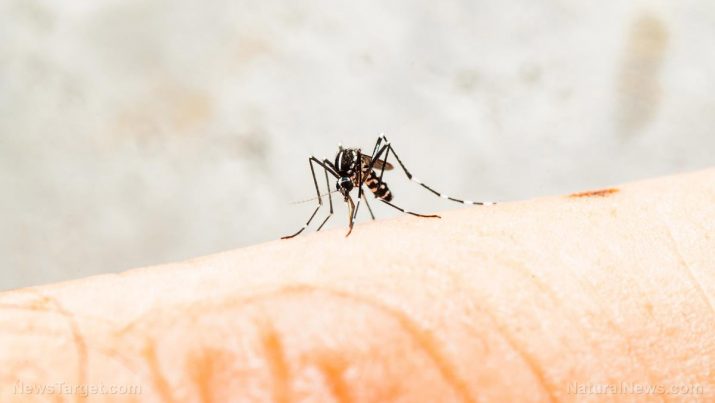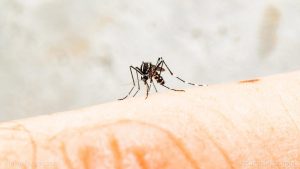
Malaria – causes, side effects and treatments at NaturalPedia.com
Tuesday, May 08, 2018 by Zoey Sky
http://www.naturalpedia.com/malaria-causes-side-effects-and-treatments-at-naturalpedia-com.html

Malaria is an infectious disease transmitted by the bite of the Anopheles mosquito. Protozoan parasites from the Plasmodium family cause the condition, and the parasites can also be transmitted via contaminated needles or transfusions.
The most deadly type of malaria is Falciparum malaria.
A patient with malaria may experience symptoms such as cycles of chills, fever, headache, muscle aches, and sweats. These symptoms will persist after several days.
Since Anopheles mosquitoes are nocturnal feeders, they often transmit malaria from dusk to dawn. Preventive measures for malaria focus on reducing contact with mosquitoes during these hours.
Malaria is also called ague, jungle fever, marsh/swamp fever, and paludism.

Known side effects of malaria
The side effects of malaria are classified into two categories: uncomplicated and severe malaria.
Uncomplicated malaria is diagnosed when the side effects are present even though there are no signs that confirm severe infection or malfunction of the vital organs. When left untreated or if the host has a weak immunity, this form of malaria may turn into severe malaria.
The symptoms of uncomplicated malaria usually last for six 10 hours and persist every second day. However, some strains of the parasite may have a longer cycle or they may cause different side effects.
Since the side effects of uncomplicated malaria are similar to the side effects of flu, the disease may remain undiagnosed or misdiagnosed in locations where malaria is uncommon.
If a patient has uncomplicated malaria, they may experience side effects in three stages: cold, hot, and sweating. The side effects of this type of malaria include:
- Feeling cold/shivering
- Fever, headaches, and vomiting
- Seizures – Often occur in younger people with uncomplicated malaria.
- Sweating, followed by the patient’s temperature returning to normal, then feeling tired
With severe malaria, vital organ dysfunction is identified via clinical or laboratory evidence. The side effects of severe malaria include:
- Abnormal bleeding and signs of anemia
- Clinical jaundice and evidence of vital organ dysfunction
- Deep breathing and respiratory distress
- Fever and chills
- Impaired consciousness
- Prostration (adopting a prone position)
- Multiple convulsions
When left untreated, severe malaria can be fatal.
Risk factors for malaria may include traveling to tropical countries all over the globe. Cases of the disease are reported in large parts of Africa and Asia, Central and South America, Haiti and the Dominican Republic, some Pacific islands (e.g., Papua New Guinea), and some parts of Middle East.
Malaria is uncommon in the United Kingdom. In the U.S., about 1,500 cases of malaria are reported yearly. Around the world, at least 3.3 billion people live in areas at risk of malaria transmission in about 106 countries and territories.
Body systems harmed by malaria
Malaria may cause the following fatal complications:
- Anemia – May be caused by the destruction of red blood cells.
- Cerebral malaria – Refers to the swelling of the blood vessels of the brain.
- Low blood sugar
- Organ failure of the kidneys, liver, or spleen
- Pulmonary edema – The accumulation of fluid in the lungs that causes breathing problems.
Food items or nutrients that may prevent malaria
The following foods or nutrients can help prevent malaria:
- Citrus fruits – Citrus fruits like oranges, lemons, and limes are full of antioxidant compounds, vitamins, and minerals that can help eliminate fever, prevent the infection from spreading and speed up the healing process.
- Ginger – Ginger contains an active ingredient called gingerol, and it has unique hydrocarbons known for their anti-inflammatory and antibacterial properties.
- Grapefruit – Grapefruit has a potent substance similar to quinine that can effectively neutralize malaria-inducing parasites.
- Holy basil – Holy basil can help ease the symptoms and severity of malaria. It contains eugenol, an active ingredient that has therapeutic properties and can help fight bacterial infections.
Treatments, management plans for malaria
Treatment for malaria is focused on eliminating the Plasmodium parasite from a patient’s bloodstream. Individuals who don’t experience any side effects may be treated for infection to lower the risk of disease transmission.
The World Health Organization (WHO) recommends Artemisinin-based combination therapy (ACT) to treat uncomplicated malaria. Artemisinin is derived from the plant called sweet wormwood (Artemisia annua). It can quickly reduce the concentration of Plasmodium parasites in a patient’s bloodstream.
ACT is artemisinin combined with a partner drug. The artemisinin in ACT helps eliminate most of the parasites in the first three days of infection and the partner drugs take care of the rest.
Where to learn more
- Anti-malaria drug given to soldiers linked to depression, killing veterans while boosting Big Pharma’s psych drug profits
- Chinese shrub offers best cure for deadly malaria
- Herbal medicine achieves stunning 100% cure rate for malaria after all pharmaceutical drugs left patients to DIE
- ‘Superbug’ malaria mosquitoes becoming resistant to insecticides
- Vitamin A and Zinc Provide Resistance to Malaria
Summary
Malaria is an infectious disease transmitted by the bite of the Anopheles mosquito. Malaria is caused by protozoan parasites from the Plasmodium family. The parasites can also be transmitted via contaminated needles or transfusions.
The side effects of malaria may include feeling cold/shivering and fever, headaches, and vomiting.
Cinnamon, citrus fruits, fever nut, ginger, grapefruit, and holy basil Cinnamon can help prevent malaria.
Treatment for malaria is focused on eliminating the Plasmodium parasite from a patient’s bloodstream. Individuals who don’t experience any side effects may be treated for infection to lower the risk of disease transmission.
The World Health Organization (WHO) recommends Artemisinin-based combination therapy (ACT) to treat uncomplicated malaria. Artemisinin is derived from the plant called sweet wormwood (Artemisia annua). It can quickly reduce the concentration of Plasmodium parasites in a patient’s bloodstream.
Sources include
Tagged Under: Tags: Malaria





